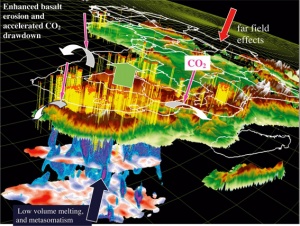ProjectA3
From !khure
Project A3:
Plateau uplift, epeirogeny and evolution of climate and biodiversity
French pi: F. Guillocheau
South African pi: M. de Wit
Contents |
Project Participants:
South Africa
- Fernando Abdala, University Witwatersrand - I - Therapsid taxonomy
- Marion Bamford, University Witwatersrand - I - Fossil wood taxonomy
- Jennifer Botha-Brink, National Museum - I - Parareptiles, Bone histology, physiology
- Doug Cole, Council for Geoscience - I - Sedimentology, lithostratigraphy
- John Compton, University of Cape Town - V - Marine Sedimentology
- Woody Cotterill, University of Cape Town - I,III - Biodiversity dynamics, palaeo drainage
- Maarten de Wit, University of Cape Town - I,II, III - Tectonics, geochronology,
- Frank Eckardt, University of Cape Town - III - Geomorphology, palaeo-drainage
- Julia Lee-Thorpe, University of Bedford - III - Biology, stable isotopes, hominims
- Johann Neveling, Council for Geoscience - I - Sedimentology, basin modelling
- Merrill Nicolas, University Witwatersrand - I - GIS database
- Rose Prevec, Albany Museum - I - Megaplant taxonomy
- Bruce Rubidge, University Witwatersrand - I - Therapsid taxonomy, biostratigraphy
- Roger Smith, SA Museum - I - Taphonomy, biodiversity changes
- Adam Yates, University Witwatersrand - I - Dinosaur taxonomy
France
- Sylvie Bourquin, Rennes 1 University - I - Fluvial sedimentology
- Jean Braun, Rennes 1 University - II - Modelling
- Luc Bulot, Marseille University - II - Biostratigraphy
- Olivier Dauteuil, Rennes 1 University - II - Tectonics
- Francois Guillocheau, Rennes 1 University - I, II, III - Sedimentology, Seismic stratigraphy
- Alain Le Herisse, Brest University - I - Palynology
- Cécile Robin, Rennes 1 University - I, II - Sedimentology, Seismic stratigraphy
- Delphine Rouby, Rennes 1 University - II - Seismic stratigraphy
- Martine Simoes, IPGP - II - Modelling
- Paul Tapponier, IPGP - II - Tectonics
- Jean-Jacques Tiercelin, Rennes 1 University - III - Sedimentology
- Annie Vincens, CEREGE, Marseille - III - Palynology
Project
The Kalahari Plateau is a 1000-1500 m high plateau that stretches ~2500 km from southern to central Africa. It is the world‟s largest subcontinental plateau away from plate margins, and is separated from the Atlantic and Indian Oceans by a narrow transition of steep scarps and mountain ranges. The origin of this plateau and its margins are not understood but can be traced back to peneplanation near sea-level during the continent-wide end-Paleozoic Gondwana glaciation (~300 My), followed by extensional intracontinental tectonics and desertification during the Late Permian-Triassic (Karoo rifts and basins) and continental break-up during the the Late Jurassic - Early Cretaceous (formation of the Atlantic and Indian Oceans). The peneplain was also affected by extensive volcanic activity: three large flood basalt events (the Karroo, 170-180 My; the Etendeka, 132 My; and the Aghulas (100-90 My) and two punctuated episodes of kimberlite emplacement (around 120 My and 90 My). By mid-end Cretaceous, uplift had started and concomittantly the inland region was transformed into a continental desert. Cenzoic evolution of the Kalahari Plateau has strongly controlled geomorphology, biological evolution (including Hominids), climate change and the hydrology of central and southern African.

The goal of this project is to quantify the growth of this major topographic feature of the Earth – the very long wave length Plateau topography, and the associated rates of uplift over the last 300 My, in order to understand the dynamics of Africa‟s surface processes (erosion, transport, sedimentation) climate change, hydrology, and biological evolution in response to landscape evolution.


